

EPR paradox. Albert Einstein The EPR paradox is an early and influential critique leveled against the Copenhagen interpretation of quantum mechanics.
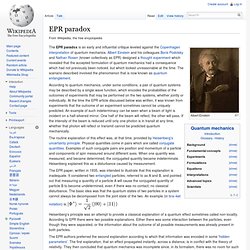
Albert Einstein and his colleagues Boris Podolsky and Nathan Rosen (known collectively as EPR) designed a thought experiment which revealed that the accepted formulation of quantum mechanics had a consequence which had not previously been noticed, but which looked unreasonable at the time. The scenario described involved the phenomenon that is now known as quantum entanglement. Cartesian Math. Euclidean -space, sometimes called Cartesian space or simply -space, is the space of all n-tuples of real numbers, ( ).
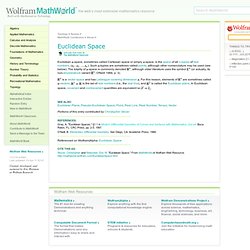
Such -tuples are sometimes called points, although other nomenclature may be used (see below). -space is commonly denoted , although older literature uses the symbol (or actually, its non-doublestruck variant ; O'Neill 1966, p. 3). is a vector space and has Lebesgue covering dimension . Are sometimes called -vectors. is the set of real numbers (i.e., the real line), and. Euclidean space. This article is about Euclidean spaces of all dimensions.
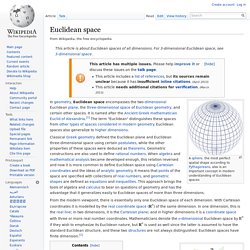
For 3-dimensional Euclidean space, see 3-dimensional space. A sphere, the most perfect spatial shape according to Pythagoreans, also is an important concept in modern understanding of Euclidean spaces Every point in three-dimensional Euclidean space is determined by three coordinates. Intuitive overview[edit] In order to make all of this mathematically precise, the theory must clearly define the notions of distance, angle, translation, and rotation for a mathematically described space. Once the Euclidean plane has been described in this language, it is actually a simple matter to extend its concept to arbitrary dimensions. Euclidean structure[edit] These are distances between points and the angles between lines or vectors, which satisfy certain conditions (see below), which makes a set of points a Euclidean space.
Where xi and yi are ith coordinates of vectors x and y respectively. Action at a distance (physics) In physics, action at a distance is the nonlocal interaction of objects that are separated in space.
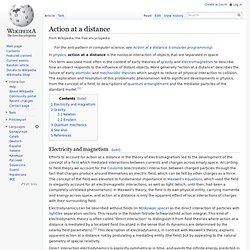
Electricity and magnetism[edit] Electrodynamics can be described without fields (in Minkowski space) as the direct interaction of particles with lightlike separation vectors. This results in the Fokker-Tetrode-Schwarzschild action integral. This kind of electrodynamic theory is often called "direct interaction" to distinguish it from field theories where action at a distance is mediated by a localized field (localized in the sense that its dynamics are determined by the nearby field parameters).[2] This description of electrodynamics, in contrast with Maxwell's theory, explains apparent action at a distance not by postulating a mediating entity (the field) but by appealing to the natural geometry of special relativity.
Direct interaction electrodynamics is explicitly symmetrical in time, and avoids the infinite energy predicted in the field immediately surrounding point particles. Force (physics) In physics, force is a push or a pull that changes or tends to change the state of rest or uniform motion of an object or changes the direction or shape of an object.
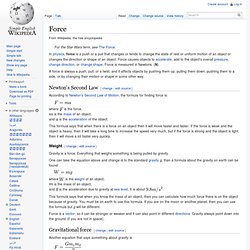
Force causes objects to accelerate, add to the object's overall pressure, change direction, or change shape. Force is measured in Newtons. (N). A force is always a push, pull, or a twist, and it affects objects by pushing them up, pulling them down, pushing them to a side, or by changing their motion or shape in some other way. Newton's Second Law[change | edit source] According to Newton's Second Law of Motion, the formula for finding force is: where. Motion (physics) If the position of a body is not changing with respect to a given frame of reference, the body is said to be at rest, motionless, immobile, stationary, or to have constant (time-invariant) position.
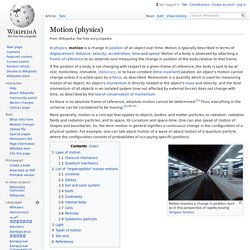
An object's motion cannot change unless it is acted upon by a force, as described. Momentum is a quantity which is used for measuring motion of an object. An object's momentum is directly related to the object's mass and velocity, and the total momentum of all objects in an isolated system (one not affected by external forces) does not change with time, as described by the law of conservation of momentum. More generally, motion is a concept that applies to objects, bodies, and matter particles, to radiation, radiation fields and radiation particles, and to space, its curvature and space-time.
One can also speak of motion of shapes and boundaries. Motion involves a change in position, such as in this perspective of rapidly leaving Yongsan Station. Mass. In physics, mass (from Greek μᾶζα "barley cake, lump [of dough]") is a property of a physical body which determines the body's resistance to being accelerated by a force and the strength of its mutual gravitational attraction with other bodies.
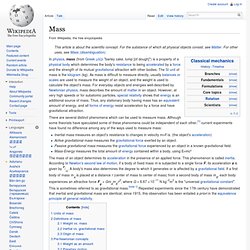
The SI unit of mass is the kilogram (kg). As mass is difficult to measure directly, usually balances or scales are used to measure the weight of an object, and the weight is used to calculate the object's mass. For everyday objects and energies well-described by Newtonian physics, mass describes the amount of matter in an object. However, at very high speeds or for subatomic particles, special relativity shows that energy is an additional source of mass. Thus, any stationary body having mass has an equivalent amount of energy, and all forms of energy resist acceleration by a force and have gravitational attraction. There are several distinct phenomena which can be used to measure mass. Time in physics. Markers of time[edit] Before there were clocks, time was measured by those physical processes[2] which were understandable to each epoch of civilization:[3] the first appearance (see: heliacal rising) of Sirius to mark the flooding of the Nile each year[3]the periodic succession of night and day, one after the other, in seemingly eternal succession[4]the position on the horizon of the first appearance of the sun at dawn[5]the position of the sun in the sky[6]the marking of the moment of noontime during the day[7]the length of the shadow cast by a gnomon[8] Eventually,[9][10] it became possible to characterize the passage of time with instrumentation, using operational definitions.